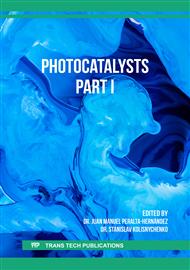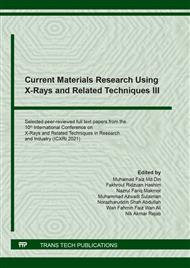[1]
D. Zhu, Q. Zhou, Action and mechanism of semiconductor photocatalysis on degradation of organic pollutants in water treatment: A review, Environmental Nanotechnology, Monitoring & Management, 12 (2019) 100255.
DOI: 10.1016/j.enmm.2019.100255
Google Scholar
[2]
A.G. Akerdi, S.H. Bahrami, Application of heterogeneous nano-semiconductors for photocatalytic advanced oxidation of organic compounds: a review, Journal of Environmental Chemical Engineering, 7 (2019) 103283.
DOI: 10.1016/j.jece.2019.103283
Google Scholar
[3]
S.S. Alias, Z. Harun, F.H. Azhar, S.A. Ibrahim, B. Johar, Comparison between commercial and synthesised nano flower-like rutile TiO2 immobilised on green super adsorbent towards dye wastewater treatment, Journal of Cleaner Production, 251 (2020) 119448.
DOI: 10.1016/j.jclepro.2019.119448
Google Scholar
[4]
Y. Li, J. Chen, J. Liu, M. Ma, W. Chen, L. Li, Activated carbon supported TiO2-photocatalysis doped with Fe ions fo continuous treatment of dye wastewater in a dynamic reactor, Journal of Environmental Sciences, 22 (2010) 1290-1296.
DOI: 10.1016/s1001-0742(09)60252-7
Google Scholar
[5]
D. Chen, Y. Cheng, N. Zhou, P. Chen, Y. Wang, K. Li, S. Huo, P. Cheng, P. Peng, R. Zhang, Photocatalytic degradation of organic pollutants using TiO2-based photocatalysts: A review, Journal of Cleaner Production, (2020) 121725.
DOI: 10.1016/j.jclepro.2020.121725
Google Scholar
[6]
S.A. Ibrahim, M.K. Anwar, A.R. Ainuddin, A. Hariri, A.Z.M. Rus, Z. Kamdi, M.Z. Yunos, Z. Harun, Synthesis and characterization of visible light active Fe-TiO2 using hydrothermal method, International Journal of Integrated Engineering, 11 (2019) 80-85.
Google Scholar
[7]
N.A. Jamalluddin, A.Z. Abdullah, Reactive dye degradation by combined Fe (III)/TiO2 catalyst and ultrasonic irradiation: Effect of Fe (III) loading and calcination temperature, Ultrasonics Sonochemistry, 18 (2011) 669-678.
DOI: 10.1016/j.ultsonch.2010.09.004
Google Scholar
[8]
R. Hussin, K.L. Choy, X. Hou, Deposited TiO2 thin films by atomic layer deposition (ALD) for optical properties, ARPN J. Eng. Appl. Sci, 11 (2016) 7529-7533.
Google Scholar
[9]
A.R. Ainuddin, N.A. Aziz, Thermal post-treatment of TiO2 films via sol-gel for enhanced corrosion resistance, ARPN J. Eng. Appl. Sci., 11 (2016) 8698-8703.
Google Scholar
[10]
S. Ibrahim, A. Nazari, Z. Kamdi, M.M. Hatta, M. Yunos, A. Rus, Z. Harun, Effect of Fe and/or N on the photoactivity of TiO2 prepared by sol-gel method, in: AIP Conference Proceedings, AIP Publishing LLC, 2019, p.020097.
DOI: 10.1063/1.5089396
Google Scholar
[11]
D. Dolat, S. Mozia, B. Ohtani, A. Morawski, Nitrogen, iron-single modified (N-TiO2, Fe-TiO2) and co-modified (Fe, N-TiO2) rutile titanium dioxide as visible-light active photocatalysts, Chemical Engineering Journal, 225 (2013) 358-364.
DOI: 10.1016/j.cej.2013.03.047
Google Scholar
[12]
S.A. Ibrahim, M.N. Ahmid, Influence of calcination temperature towards Fe-TiO2 for visible-driven photocatalyst, in: Materials Science Forum, Trans Tech Publ, 2017, pp.435-440.
DOI: 10.4028/www.scientific.net/msf.888.435
Google Scholar
[13]
T. Suwannaruang, J.P. Hildebrand, D.H. Taffa, M. Wark, K. Kamonsuangkasem, P. Chirawatkul, K. Wantala, Visible light-induced degradation of antibiotic ciprofloxacin over Fe–N–TiO2 mesoporous photocatalyst with anatase/rutile/brookite nanocrystal mixture, Journal of Photochemistry and Photobiology A: Chemistry, 391 (2020) 112371.
DOI: 10.1016/j.jphotochem.2020.112371
Google Scholar
[14]
M. Bellardita, A. Di Paola, B. Megna, L. Palmisano, Determination of the crystallinity of TiO2 photocatalysts, Journal of Photochemistry and Photobiology A: Chemistry, 367 (2018) 312-320.
DOI: 10.1016/j.jphotochem.2018.08.042
Google Scholar
[15]
S. Hu, F. Li, Z. Fan, C.-C. Chang, Enhanced photocatalytic activity and stability of nano-scaled TiO2 co-doped with N and Fe, Applied surface science, 258 (2011) 182-188.
DOI: 10.1016/j.apsusc.2011.08.028
Google Scholar
[16]
M. Zhou, J. Yu, B. Cheng, Effects of Fe-doping on the photocatalytic activity of mesoporous TiO2 powders prepared by an ultrasonic method, Journal of hazardous materials, 137 (2006) 1838-1847.
DOI: 10.1016/j.jhazmat.2006.05.028
Google Scholar
[17]
Y. Wang, Z.-H. Jiang, F.-J. Yang, Effect of Fe-doping on the pore structure of mesoporous titania, Materials Science and Engineering: B, 134 (2006) 76-79.
DOI: 10.1016/j.mseb.2006.07.026
Google Scholar
[18]
A. Sikirman, J. Krishnan, Effect of calcination temperature on synthesis of N-Fe-TiO2 for photocatalytic degradation of methylene blue under visible light, in: Applied Mechanics and Materials, Trans Tech Publ, 2014, pp.55-59.
DOI: 10.4028/www.scientific.net/amm.575.55
Google Scholar
[19]
X. Li, Z. Chen, Y. Shi, Y. Liu, Preparation of N, Fe co-doped TiO2 with visible light response, Powder technology, 207 (2011) 165-169.
DOI: 10.1016/j.powtec.2010.10.024
Google Scholar
[20]
R.A. Spurr, H. Myers, Quantitative analysis of anatase-rutile mixtures with an X-ray diffractometer, Analytical chemistry, 29 (1957) 760-762.
DOI: 10.1021/ac60125a006
Google Scholar




